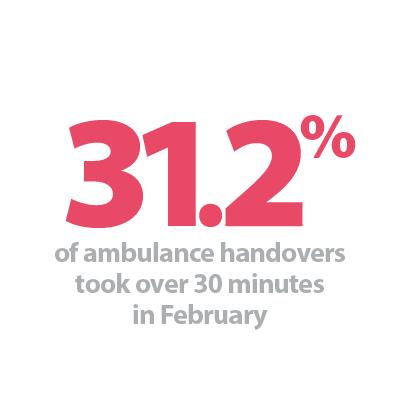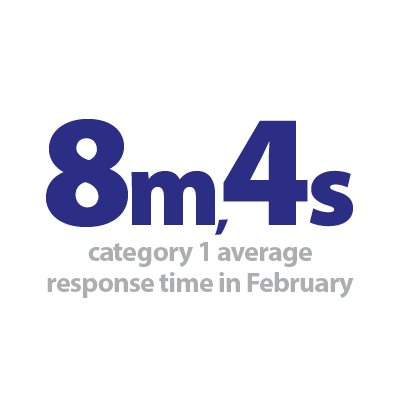


Demand and activity
The number of incidents fell in February, but this winter period saw a record number compared to previous winters. This highlights the intensity of demand for the ambulance service:
- There were 699,840 incidents in February, down by nearly 10% from 777,060 last month. But over winter, there were over 2.28m incidents, which is the highest recorded in any winter period.
- There were nearly 72,000 category 1 incidents (life-threatening injuries and illnesses), an 11.5% decrease compared to last month. Compared to a year ago, the number is 6% lower but 27% higher than before the pandemic.
- Over the winter period, category 1 incidents were 246,070, only slightly lower than last year's record (246,400).
- There were 356,090 category 2 incidents recorded in February, down by 11% compared to the previous month. February's figure is 5% lower than last year and February 2020, before the pandemic.
- There were 1.18m category 2 incidents this winter, lower than last year (1.19m) and the last two winters before the pandemic (2018/19: 1.19m, 2019/20: 1.23m).
In some parts of the country, ambulance trusts also provide NHS 111 services, which now also provides dedicated support for those experiencing a mental health crisis:
- In January 2025, 1.67m calls were received by NHS 111, equating to 53,740 calls received per day. Of these, 1.59m calls (95.7%) were answered. This is 12.6% fewer calls answered than December, 3.8% fewer calls than a year ago but nearly 20% more than before the pandemic.
- Over 162,000 calls were made to NHS 111 'select mental health' option in January, which was introduced to streamline access to mental health support in England. Of these calls, 64.9% were answered, an average of 5,420 per day. This is a 3.6% increase on the previous month and has almost doubled since the service opened in April 2024.
Response times
The national ambulance response time targets are seven minutes for category 1 incidents and 18 minutes for category 2 incidents. As part of the plan to recover urgent and emergency care, NHS England adjusted the category 2 target to 30 minutes, on a temporary basis. The fall in demand is likely to have contributed to the improvement in response times this month:
- The average response time across England for category 1 incidents was eight minutes and four seconds, a 12 second improvement from January, but still missing the seven-minute target. This is the shortest February response time since 2021 (see figure 5).
- The average response time for category 2 incidents was 31 minutes and 22 seconds, a four minute and 18 second improvement on the previous month but falling short of the 30-minute target. This is also the shortest February response time since 2021.
- One region, the northeast, met the seven-minute category 1 target again this month.
- Six ambulance services met the 30-minute target for category 2 response times in the latest month. Regional variations persist but were smaller this month, with only one service recording an average response time of over 40 minutes.
Figure 5
Ambulance response times for category 1 incidents

- There was a total of 365,850 ambulance handovers in February 2025, a decrease of 9.4% on January. Of these, 69.2% took over 15 minutes, 31.2% took over 30 minutes and 11.1% took over an hour. Delays improved at all time intervals for the second month running in February.
In the winter section of this edition, we summarise ambulance handover data over the 2024/25 winter period.